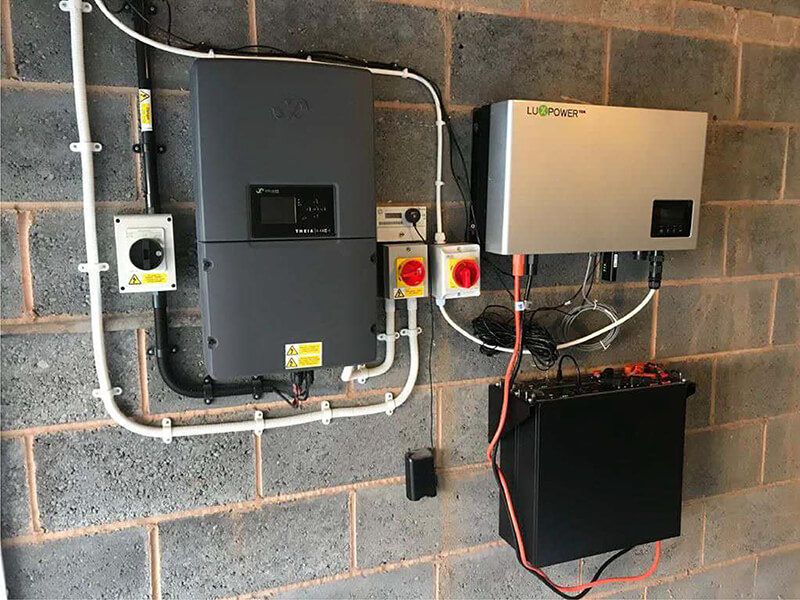The lifespan of solar panels ranges from 25 to 30 years, but inverters only last for 10 to 15 years, which means you will need to replace the solar inverter midway through its use to ensure the optimal operation of the solar system. The lifespan of different types of solar inverters varies. String inverters have a lifespan of 5 to 10 years, while micro-inverters last for 10 to 15 years. In this article, we will introduce to you how to extend the lifespan of solar inverters and other related knowledge.
The average lifespan of solar inverters is a key component of any solar system, converting the direct current (DC) generated by solar panels into alternating current (AC) for home appliances and feeding into the power grid. The average service life of solar inverters is typically 10 to 15 years, depending on various factors, including inverter type, installation quality, and environmental conditions. How long is the lifespan of different types of solar inverters? String inverters have a lifespan of about 5 to 10 years. They are commonly used in residential systems that connect multiple solar panels in series. Their shorter lifespan can be attributed to their exposure to various environmental factors and wear caused by operating at full capacity during peak sunlight hours. Micro-inverters usually have a longer lifespan, around 10 to 15 years. Installed on individual solar panels, they offer greater flexibility and efficiency. Their extended lifespan may be related to their ability to operate independently, reducing stress on the inverter. They tend to be less affected by shading and module mismatch, thereby improving overall performance. Power optimizers, similar to micro-inverters, have a lifespan of about 10 to 15 years. These devices are installed on each solar panel but remain connected to a central inverter. They increase energy production by maximizing the output of each panel, and their design helps mitigate wear related to the full system load. Hybrid inverters can manage both solar and battery storage and typically have a lifespan of about 10 to 15 years. Their long lifespan benefits from advanced technology that can effectively manage energy flow and reduce system stress. What factors determine the lifespan of solar inverters? Component quality: High-quality materials and components can extend the lifespan of inverters. Cheaper models with inferior parts are more prone to failure. Investing in high-quality inverters can extend their lifespan and improve performance. Environmental conditions: Inverters exposed to extreme temperatures, humidity, dust, or moisture will wear out faster.Adequate ventilation and protective covers can help mitigate these effects.
Installation quality: A properly installed inverter is less likely to have operational problems. Poor installation practices, such as insufficient cooling or improper wiring, can lead to early failures. Workload: An inverter that operates continuously at maximum capacity or near maximum capacity will experience greater wear and tear. Frequent cycling between high and low loads can put stress on components. You should choose the right inverter size for your solar system. Extending the lifespan of solar inverters Regular maintenance practices: cleaning, inspection, and checking. Schedule routine inspections to check for signs of wear or damage, such as loose connections, corrosion, or overheating. Regularly clean the exterior of the inverter to remove dust, debris, and other contaminants that may impede airflow and cause overheating. In addition to visual inspections and cleaning, perform electrical inspections and tests to verify the integrity of inverter components and connections. Check the inverter display or monitoring system for any error codes or fault indicators and address issues promptly to prevent further damage. Upgrades and modifications: improve inverter efficiency and lifespan. With technological advancements, new solar inverters offer improved efficiency, reliability, and performance compared to older models. Consider upgrading or retrofitting your solar system with a new inverter to take advantage of these benefits and extend the lifespan of the system. In some cases, retrofitting an existing inverter with additional features or components, such as surge protection or a cooling system, can help improve its durability and lifespan. Utilize warranty and service plans: maximize protection for your investment. Many solar inverter manufacturers offer warranty and service plans to protect against defects and failures and provide peace of mind for solar system owners. Utilize these warranty and service plans to maximize protection for your investment and ensure timely repair or replacement when needed. If your inverter has any problems or malfunctions, contact the manufacturer or an authorized service provider to file a warranty claim and request assistance with repair or replacement. Frequently Asked Questions about the lifespan of solar inverters What is the typical warranty period for solar inverters? The standard warranty period for most solar inverters is 5 to 10 years, but some manufacturers may offer longer warranties of up to 25 years for premium products. Can I replace the inverter myself or do I need a professional? Although some DIY-savvy homeowners may attempt to replace a solar inverter themselves, it is usually recommended to hire a qualified professional to replace the inverter.Solar inverters involve high-voltage electrical components and the installation procedure is complex. Therefore, it is necessary to ensure that the work is completed safely and correctly to avoid damage to the inverter or solar system. How can we evaluate the health status of a solar inverter? Monitoring the performance of the solar system and regularly checking the inverter for signs of wear or damage are effective methods to evaluate the health status of a solar inverter. Monitoring systems that provide real-time data on energy production and inverter performance can help identify any anomalies or inefficiencies that may indicate inverter problems. Experience the powerful functions of Shielden’s high-quality inverters! Our inverters have a service life of up to 15 years and are designed to provide reliable performance for a long time. Shielden provides a comprehensive long-term warranty for our products to ensure that your investment is protected. Choose Shielden and enjoy unparalleled quality and peace of mind on your solar journey!
